I was given in classroom some theory on operational amplifiers, how to apply Kirchoff's Laws and apply the ideal conditions to understand the general working principles of the circuits using it,

simulate this circuit – Schematic created using CircuitLab
I understand the next set of equations are valid for the design given:
\begin{cases}
\frac{V-V_{in}}{R_{1}}= & \frac{V_{out}-V_{in}}{R_{1}+R_{f}}
\end{cases}
\begin{cases} V_{out}= & -A_{VOL}V \end{cases}
But I don't get how the next equations is justified, I was told only it comes from the previous ones, and after a while I can't derive how to obtain the next arrangement:
\$A_{V}=\frac{V_{out}}{V_{in}}=\frac{A_{VOL}R_{f}}{-R_{1}-R_{f}-A_{VOL}R_{1}}\$
so I try to get the transfer function first (taking into account this is a inverter opamp configuration) \$\frac{V-V_{in}}{R_{1}}=\frac{V_{out}}{R_{1}+R_{f}}-\frac{V_{in}}{R_{1}+R_{f}}\$ \$\frac{V}{R_{1}}-\frac{-V_{in}}{R_{1}}=\frac{V_{out}}{R_{1}+R_{f}}-\frac{V_{in}}{R_{1}+R_{f}}\$
\$\frac{V}{R_{1}}-\frac{-V_{in}}{R_{1}}+\frac{V_{in}}{R_{1}+R_{f}}=\frac{V_{out}}{R_{1}+R_{f}}\$
\$V_{in}(\frac{1}{R_{1}+R_{f}}-\frac{1}{R_{1}})+\frac{V}{R_{1}}=\frac{V_{out}}{R_{1}+R_{f}}\$
\$v_{+}=v_{-}=V=0\ V \$
\$V_{in}(\frac{1}{R_{1}+R_{f}}-\frac{1}{R_{1}})=\frac{V_{out}}{R_{1}+R_{f}}\$
\$V_{in}(\frac{R_{1}-(R_{1}+R_{f})}{R_{1}(R_{1}+R_{f})})=\frac{V_{out}}{R_{1}+R_{f}}\$
\$(R_{1}+R_{f})(\frac{R_{1}-(R_{1}+R_{f})}{R_{1}(R_{1}+R_{f})})=\frac{V_{out}}{V_{in}}(\frac{R_{1}-(R_{1}+R_{f})}{R_{1}})=\frac{V_{out}}{V_{in}}\$
\$(\frac{R_{1}-R_{1}-R_{f})}{R_{1}})=\frac{V_{out}}{V_{in}}\$
\$H(s)=(\frac{-R_{f})}{R_{1}})=\frac{V_{out}}{V_{in}}\$
Indeed \$H(s)\$ looks like the expected form, but I have no idea how to to get the former expression of AVOL or what it means.
So, what do these equations mean and how can I get it:
\$A_{V}=\frac{V_{out}}{V_{in}}=\frac{A_{VOL}R_{f}}{-R_{1}-R_{f}-A_{VOL}R_{1}}\$

